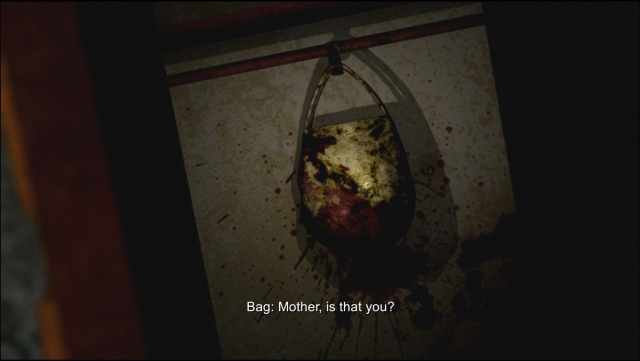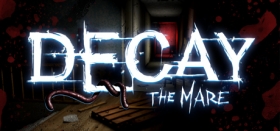
Decay: The Mare Review
“What is a friend?” asks Decay: The Mare. When I started the game and saw this question, which is made explicit in its second and third episode, I was really excited and intrigued by every connotation that it could entail. Particularly, after playing the first episode, I started wondering about how this game was going to treat friendly characters, about the futility of the word ‘friend’ in videogames and how it may affect our daily lives. I also wondered if the game was going to be a study on the nature of friendship or its fickleness. It surprisingly does, more or less. Decay: The Mare is better seen as a piece about human drives, both friendly and aggressive, than as a terrifying and butt-tightening experience. It advertises itself as a horror-based game, when it is not. In fact, everything that is supposed to be horror-y just fails miserably.
Let’s start by talking about mechanics. Decay: The Mare is a first-person point-and-click adventure, which means that you see (more or less) what the controlled character, Sam, would see, from the exact same point of view. The problem here is that the views are completely static. This means that there is no mobility involved in the mechanics of this game. You can only see the two or three angles of the room that the game gives you, which is a cheap tactic to make you feel vulnerable. Let me explain why jump-scares never work with a point-and-click-based mechanic: have you ever been sitting in a dark room, to suddenly be startled by the sound of something, let’s say, a lamp, smashing against the floor? Well, now imagine the same scenario, but you are looking directly at that lamp, slowly tilting due to its own weight, and finally plummeting to hit the ground with a loud noise. You expect that noise; you know the reason why that lamp fell and the exact moment it is going to hit the ground, because you’re looking at it! Well, that’s what Decay: The Mare presents to the player: a series of pictures you can interact with, where sometimes, something moves and makes a loud noise, but because it’s the only thing moving in the picture, your eyes are drawn to it, so nothing, and I guarantee, nothing, will startle you in this game. I could not finish Amnesia, I could not finish Outlast, I barely could finish BioShock, but this game was a piece of cake to me in terms of how scary it was. Everything that happens, every script or interaction, is telegraphed much ahead it happens by the music, the setting, the atmosphere, and the plot, so you always know when to expect something.
I’m not going to deny the eeriness set by the music and setting, or by the shadows moving in the background. The setting in Decay is very lugubrious, indeed: the game has a peculiar blue and brown white balance, and the characters’ models (the very few that you find) slightly fall under the uncanny valley, which seems to be done very much on purpose. On top of this, there is a constant pixelated fog, as though your screen was struggling to see what’s in the dark. The biggest flaw, however, is that, despite all this, you never feel threatened at all. But it is solely a flaw because it tries to make you feel that way. Let’s take Amnesia, for example; your movement from one place to another is key in delivering an atmosphere in which you feel unsafe. You don’t know where to look, or where to hide, which makes this game terribly tense and daunting. In Decay: the Mare, there is no hiding, or movement, or control of camera angles, or a frame of time for your actions. Something as simple as a strange noise is counter-productive and shouldn't be included in this type of game because you can’t look for its source, it can’t be located clearly if it’s not in a dynamic 3D space. Even if it were, turning to look at it involves clicking twice on an arrow at the edge of the screen to change the image you’re looking at, but that is likely to have the player moving spatially, rather than rotating on the spot, causing disorientation when looking for the source of the noise. In turn, you’re going to end up more annoyed and confused than scared. What I’m trying to say is that you know that the game is not going to throw anything threatening at you which you have to actively deal with, such as a monster, simply because you don’t have tools to deal with it: no weapons, no possibility of hiding or running, no combat, etc. I’m not saying this is bad, I’m saying that in terms of mechanics, those chosen in this game don’t convey any sense of danger, fear or even tension; they are a mistake in terms of expression.
Having said that, I do think that there are very good mechanics in this game, particularly when combined with the semiology of the objects you interact with. The puzzles, for once in a point-and-click adventure, have logical answers. This means although the puzzle itself and its connection with the outcome don’t really make any sense at all, the objects that you interact with to solve the puzzle do. I remember playing Monkey Island, often having to follow guides to solve it, while asking myself who would use a rubber chicken to zip-line to the other side of the river. In Decay: The Mare, you need a hammer to knock a wall down and a crowbar to open a hatch. Simple, logical, understandable. However, leaving pieces of paper on top of a table… turns the lights on? Hey, whatever: I could solve the puzzle; it’s supposed to be a nightmare anyway.
The different objects you use when trying to solve these puzzles were clearly quite carefully selected. All of them have some sort of meaning or relation to other elements in the plot: from the cell in the beginning to the figure of the mannequin, they all contribute to create a cohesive narrative whole. I won’t spoil anything, but if you happen to play this game, try to remember every object that you've used previously and how they link with the story further on. What’s more, these elements (such as the moving pictures or the figure of the mannequin) become part of the game in the sense that they become the defining elements of the game, much like the wrench was to System Shock 2 or Bioshock; or the desert to Spec-Ops: The Line, for instance.
This leads me to my next point: the semantics and overall subject of the game. As I explained before, this game is not really scary. It does set an atmosphere, and as the puzzles are quickly solvable, it also sets a good pace which immerses the player even more. However, it’s more of an eerie and grisly atmosphere than a scary one. For example, there is a character that you encounter quite early on, called Bag. It is, as far as the player knows, a child that has been maimed and dismembered, but in a bag. As a matter of fact, the interaction with this character turns out to be rather comforting (not in a cuddly way, however). At the beginning, when you first find him it is really creepy, but by the end you are happy to find him! It does not scare you at all, but it certainly makes you feel uneasy.

You see, the characters in this game are very dodgy-looking, but almost none of them try to hurt you. In fact, most of them are helping you out constantly! Even the ones in pictures and paintings, which can barely be considered characters, provide you with essential clues to advance in the game. This is the point that I was talking about in the beginning of this review: who you’re calling a friend and the reasons for it, and how the answers to these questions changes in different contexts. This game presents characters with very different backgrounds but with a similar friendly attitude towards you. There is a part where the player-controlled character asks “Why are you helping me?” to another character. I think incentivizing this line of thought with “What is a friend?” is bloody brilliant! It’s true, it may restrict what we look at in the plot, but I don’t think it is such a bad idea to do so. This is a very concise game, with only a little over three hours of gameplay, so I’m glad they make sure I know what the game’s strongest narrative foundations are about. Well, at least, this is what I think the game is about, as there was one thing that threw me off towards the very end of the game. Some smartass during development decided to answer the question “What is a friend?” with the most esoteric, pretentious and irrelevant one-liner I have ever seen. I had enjoyed my experience up until I read this. Please, if you’re reading this and have played the game, and have any idea what it means, I urge you to get in touch and explain it. I've got the feeling that it still remains from earlier development, where maybe there was a different plot. I assure you that as far as my fairly big ape brain can comprehend, the provided answer to the question is utterly irrelevant.
Maybe I would have some perspective if I had played the previous Decay games, but I was, back when they came out, probably busier with… Call of Duty, I don’t know. I think this game could have probably done better if instead of trying to scare you, it tried to invoke that part of the brain where the subconscious lives, making this story personal and relatable, much like Silent Hill 2 did. Maybe for the next Decay we’ll see a title that grasps your innermost emotions and stir them until you feel embarrassed and guilty, or vulnerable, or even scared of how vulnerable you can be. Maybe the next Decay forgets about mainstream jump scares and digs more into your head, as puzzles and point-and-click are a great way to do so.
Also, am I the only one who can’t stop thinking of horses every time I read the title of the game?
Decay: The Mare (Reviewed on Windows)
Game is enjoyable, outweighing the issues there may be.
Don’t come to this game looking for horror, but an emotional and shocking story, that makes you think along the way while having good pace and engaging puzzles.










COMMENTS